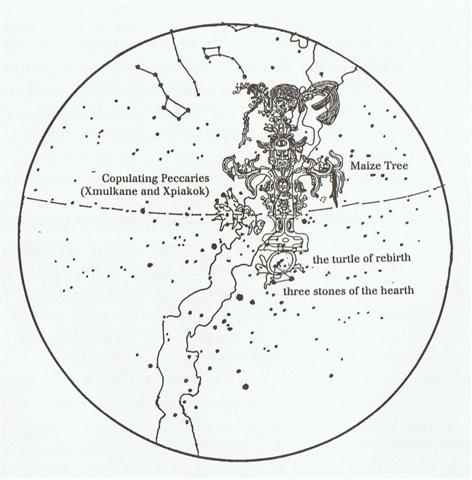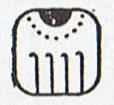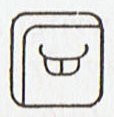The Babylonian order had Mercury before Jupiter in the week - in Wednesday, the day of turning around. But in their sky it was the opposite - the Jupiter part of the year was earlier than that of Mercury:
The sign of Jupiter resembles 24 and that of Mecury the sign for a female. 24 could allude to the last hour of the year and Mercury (Hermes, etc) was a man with female traits. Due to the precession the position of Mercury could have moved ahead one place around the table of the year, leaving his former central place to Jupiter. But then Jupiter (Father of Light) must once have had his place at the northern spring equinox - which would explain his name and 24. The planet Mercury could not - like us people living down on earth - go very high up nor very far down. ... The divine first appears abstractly, as generative-spirit-in-itself. Only after seven epochs of the po, the long night of the world's self-generation, are the gods as such born - as siblings to mankind. God and man appear together, and in fraternal strife over the means of their reproduction: their own older sister. Begun in the eighth epoch of creation, this struggle makes the transition to the succeeding ages of the ao, the 'day' or world known to man. Indeed the struggle is presented as the condition of the possibility of human life in a world in which the life-giving powers are divine. The end of the eighth chant thus celebrates a victory: 'Man spread about now, man was here now; / It was day [ao].' And this victory gained over the god is again analogous to the triumph achieved annually over Lono at the New Year, which effects the seasonal transition, as Hawaiians note, from the time of long nights (po) to the time of long days (ao). The older sister of god and man, La'ila'i, is the firstborn to all the eras of previous creation. By Hawaiian theory, as firstborn La'ila'i is the legitimate heir to creation; while as woman she is uniquely able to transform divine into human life. The issue in her brothers' struggle to possess her is accordingly cosmological in scope and political in form. Described in certain genealogies as twins, the first two brothers are named simply in the chant as 'Ki'i, a man' and 'Kane, a god'. But since Ki'i means 'image' and Kane means 'man', everything has already been said: the statuses of god and man are reversed by La'ila'i's actions. She 'sits sideways', meaning she takes a second husband, Ki'i, and her children by the man Ki'i are born before her children by the god Kane ... In the succeeding generations, the victory of the human line is secured by the repeated marriages of the sons of men to the daughters of gods, to the extent that the descent of the divine Kane is totally absorbed by the heirs of Ki'i ... In the Moriori sequence of the sons of Tu the name Tiki occurs twice whereas none of the other names occurs more than once: ... the progeny of Tu increased: Rongo, Tane, Tangaroa, Rongomai, Kahukura, Tiki, Uru, Ngangana, Io, Iorangi, Waiorangi, Tahu, Moko, Maroro, Wakehau, Tiki, Toi, Rauru, Whatonga - these were the sons ... This could possibly mean Tiki referred to the equinoxes (with 18 days for each of the sons of Tu):
Counting form Rongo to the first Tiki would then measure up to 5 * 18 = 90 days and this Rongo could be at the beginning of January with the first Tiki at the beginning of April. The 2nd Tiki would then come around day 90 + 180 = 270. However, the manu kake glyphs in the G text could suggest time 'stood still' for 44 days and instead of a cycle with 360 (= 18 * 20) days we maybe should add twice 44 (because also the nakshatra nights in the calendar would have reflected the days when the gods were unable to launch their great canoe):
366 + 44 + 44 = 454 = 472 - 18 = 12 * 29½ + 100 = 354 + 118 = 6 * 59 + 3 * 59. Tiki (the Man) could have referred to Jupiter, the Oak Tree, the top of which supported the sky roof and the roots of which were at the opposite side of his cycle:
In this picture of Yggdrasil we can see there is a little tree growing high up from the top of the central mountain and at bottom there is another great old oak holding earth in place. Jupiter spelled order and Mercury disorder. ... And then the bone spoke; it was there in the fork of the tree: Why do you want a mere bone, a round thing in the branches of a tree? said the head of One Hunaphu when it spoke to the maiden. You don't want it, she was told. I do want it, said the maiden. Very well. Stretch out your right hand here, so I can see it, said the bone. Yes, said the maiden. She stretched out her right hand, up there in front of the bone. And then the bone spit out its saliva, which landed squarely in the hand of the maiden. And then she looked in her hand, she inspected it right away, but the bone's saliva wasn't in her hand. It is just a sign I have given you, my saliva, my spittle. This, my head, has nothing on it - just bone, nothing of meat. It's just the same with the head of a great lord: it's just the flesh that makes his face look good. And when he dies, people get frightened by his bones. After that, his son is like his saliva, his spittle, in his being, whether it be the son of a lord or the son of a craftsman, an orator. The father does not disappear, but goes on being fulfilled. Neither dimmed nor destroyed is the face of a lord, a warrior, craftsman, an orator. Rather, he will leave his daughters and sons. So it is that I have done likewise through you. Now go up there on the face of the earth; you will not die. Keep the word. So be it, said the head of One and Seven Hunaphu - they were of one mind when they did it ...
... 'Tell us a story!' said the March Hare. 'Yes, please do!' pleaded Alice. 'And be quick about it', added the Hatter, 'or you'll be asleep again before it's done.' 'Once upon a time there were three little sisters', the Dormouse began in a great hurry: 'and their names were Elsie, Lacie, and Tillie; and they lived at the bottom of a well — ' 'What did they live on?' said Alice, who always took a great interest in questions of eating and drinking. 'They lived on treacle,' said the Dormouse, after thinking a minute or two. 'They couldn't have done that, you know', Alice gently remarked. 'They'd have been ill.' 'So they were', said the Dormouse; 'very ill'. Alice tried a little to fancy herself what such an extraordinary way of living would be like, but it puzzled her too much: so she went on : 'But why did they live at the bottom of a well?' 'Take some more tea [= t as in duration of time]', the March Hare said to Alice, very earnestly. 'I've had nothing yet', Alice replied in an offended tone: 'so I can't take more'. 'You mean you can't take less', said the Hatter: 'it's very easy to take more than nothing'. 'Nobody asked your opinion', said Alice. 'Who's making personal remarks now?' the Hatter remarked triumphantly. Alice did not quite know what to say to this: so she helped herself to some tea and bread-and-butter, and then turned to the Dormouse, and repeated her question. 'Why did they live at the bottom of a well?' The Dormouse again took a minute or two to think about it, and then said 'It was a treacle-well.' 'There's no such thing!' Alice was beginning very angrily, but the Hatter and the March Hare went 'Sh! Sh!' and the Dormouse sulkily remarked 'If you ca'n't be civil, you'd better finish the story for yourself.' 'No, please go on!' Alice said very humbly. 'I wo'n't interrupt you again. I dare say there may be one.' 'One, indeed!' said the Dormouse indignantly. However, he consented to go on. 'And so these three little sisters - they were learning to draw, you know —' 'What did they draw?' said Alice, quite forgetting her promise. 'Treacle', said the Dormouse, without considering at all, this time. 'I wan't a clean cup', interrupted the Hatter: 'let's all move one place on.' He moved as he spoke, and the Dormouse followed him: the March Hare moved into the Dormouse's place, and Alice rather unwillingly took the place of the March Hare. The Hatter was the only one who got any advantage from the change; and Alice was a good deal worse off than before, as the March Hare had just upsed the milk-jug into his plate ... The Dormouse told of 3 little sisters at the bottom of a well and I guess these sister could have referred to Tau-toru (3 stars), to Orion's Belt where time stood nearly still awaiting the new fire - i.e. when time ran like treacle. The sleepy Doormouse (French dormir, sleep) could have represented the Exit Door frame of Hercules (the Oak, Jupiter): ... The seventh tree is the oak, the tree of Zeus, Juppiter, Hercules, The Dagda (the chief of the elder Irish gods), Thor, and all the other Thundergods, Jehovah in so far as he was 'El', and Allah. The royalty of the oak-tree needs no enlarging upon: most people are familiar with the argument of Sir James Frazer's Golden Bough, which concerns the human sacrifice of the oak-king of Nemi on Midsummer Day. The fuel of the midsummer fires is always oak, the fire of Vesta at Rome was fed with oak, and the need-fire is always kindled in an oak-log. When Gwion writes in the Câd Goddeu, 'Stout Guardian of the door, His name in every tongue', he is saying that doors are customarily made of oak as the strongest and toughest wood and that 'Duir', the Beth-Luis-Nion name for 'Oak', means 'door' in many European languages including Old Goidelic dorus, Latin foris, Greek thura, and German tür, all derived from the Sanskrit Dwr, and that Daleth, the Hebrew letter D, means 'Door' - the 'l' being originally an 'r' ... Possibly a new Mayan Maize Tree originated 4 * 20 = 80 days after the 'Skeleton Tree' (Kan-kin), becaue the base of the Cumhu glyph illustrated maize (or food in general). Kan = yellow, maize and kin = gold, sun.
... My arrangement has 15 Moan as the first month of 'winter', i.e. the time of the year corresponding to when sun has gone down in the west in the evening. The mouth which opened wide in spring (cfr 4 Zotz) to allow Sun to enter (in 5 Tzek) has closed again in 15 Moan to show that darkness has returned. The outside 3 black dots in 16 Pax are much greater than those in 9 Ch'en. Darkness falls first with the onset of the rain clouds (the grapelike hanging formation) and then when Sun leaves in autumn. 15 Moan is my candidate for an owl. However, Gates is of the opinion that it is a falcon: 'Six glyphs at least are clearly pictographic in base: Pop, mat; Sotz, bat; Xul, ?; Kankin, skeleton ribs; Moan, falcon; Kayab, turtle.' (Gates) The 'skeleton ribs' in 14 Kankin should be regarded as a version of the 'Tree', I guess ... The all-important life supporting maize had to be their World Tree, I suppose:
This Maize Tree grew up from a crack in the dry shell of the earth turtle, we can read. At left is a figure which holds a sweet water jar and at right is his twin brother with the life-supporting air. The first day sign was Imix (water, sea-dragon, wine) and the second was Ik (air, life).
Tane lifted up the sky roof in order to let air in, creating a world of light and life: ... Taane Mahuta, the god of the forests, was the most determined; he set his sturdy feet upon his father's chest, and braced his upper back and shoulders against the bosom of his mother. He pushed; and they parted. So the world; as the Maori understand it; came into being ... Easily we can perceive a correspondence between Ik, Tane, and the twin at right in the picture above (which is a mirror version of the original - I have reversed its order because the Mayas read from right to left). Next it would be suprising if we could not similarly correspond Imix respectively Rogo with the twin at left.
Before the sky roof had been uplifted to let in the spring light the primary sense organ was not the eye but the ear. And from there the connection with sweet rain water would have been a natural step: ... It was 4 August 1968, and it was the feast day of Saint Dominic, patron of Santo Domingo Pueblo, southwest of Santa Fe. At one end of the hot, dusty plaza, a Dominican priest watched nervously as several hundred dancers arranged in two long rows pounded the earth with their moccasined feet as a mighty, collective prayer for rain, accompanied by the powerful baritone singing of a chorus and the beat of drums. As my family and I viewed this, the largest and in some ways the most impressive Native American public ceremony, a tiny cloud over the Jémez Mountains to the northwest got larger and larger, eventually filling up the sky; at last the storm broke, and the sky was crisscrossed by lightning and the pueblo resounded with peals of rolling thunder ... |
|||||||||||||||||||||||||||||||||||||||||||||||||||||||||||||||||||||||||||||||||||||||||||||||||||||||||||||||||||||||||||||||||||||||||||||||||||||||||||||||||||||||||||




























